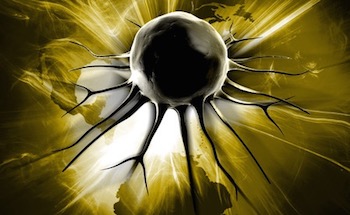For the first time, a team of scientists has been able to capture the image of certain proteins, which could not be done previously because they were too small or could not maintain a natural state, among other reasons. These high resolution images of cancer cells provide new information about the protein structures and interactions that are vital for the activity of a cancer cell, and which could be used to drug developers in a search for a cure for cancer.
What is the Technology
From several entities of the National Institutes of Health (NIH), the scientists, led by Sriram Subramaniam, PhD, of the National Cancer Institute (NCI) Center for Cancer Research, are using cryo-electron microscopy (cryoEM) to analyze and image molecules, so they can draw conclusions about the way the structure works. At cryogenic temperatures in a range of -180°C to -269°C, they have been able to observe the specimens in their native environment. Simply put, the native state of the samples is preserved in a very thin, liquid, frozen-hydrated film which is rapidly plunged into a liquid ethane bath. Basically, the film is flash frozen with liquid nitrogen. Then, a two dimensional image is captured using electrons. Subsequently, the researchers create thousands of these 2-D images of the molecules in numerous orientations and average them together. What results is a three-dimensional image of the biological object. This technology was named “Method of the Year” for 2015 by Nature Methods.
Why is this so noteworthy?
While cryoEM technology has been around for several years and electron microscopy for decades, the improvement here is in the resolution of the images. By using such cold temperatures, the damage from electrons during the process is reduced and instead of pictures that look like blobs, the resolution is so high that atomic models can be produced. This is applicable in fields like cancer signaling, drug development and cellular metabolism.
CryoEM overcomes two significant barriers: getting better resolution and getting images of proteins structures smaller than 100 kilodaltons (kDa – a unit of measurement for molecular weight). Resolution is measured in Ångströms (Å), which is equal to one-ten billionth of a meter, while the old technologies could not get below the 2.0 Å threshold. The higher the Ångströms, the less fine and rougher the image will be.
Previously, in order to see the molecular complexes and determine their structural mechanism, either X-ray crystallography or nuclear magnetic resonance spectroscopy (NMR) would be employed. The benefit of cryoEM compared to these other methods is that the sample does not need to be crystallized (which is extremely difficult, if not impossible to do on some proteins) and can be used for both big and small complexes. Further, the sample need not be fixed or stained, increasing the ability to see it in its natural state.
The near-atomic resolution now achieved with the cryoEM would not have been possible without some other advances. For example, the development of a new type of camera, called direct electron detectors, provided better signal detection. Also, more computing power and new algorithms for processing images let researchers mine more information out of the existing EM images.
Applying cryoEM
Dr. Sriram Subramaniam and his team reported that they had been able to use cryoEM to visualize, at the atomic resolution of 2.3 to 3.3 Å, the structure of a cancer protein called p97, which is an attractive target for cancer drug development. In his earlier work, he and his team separately visualized both p97 alone and p97 bound to a small molecule anticancer drug. Upon seeing this, the team was led to conclude that a higher resolution image of 2.3 to 3.3 Å was technically possible. Additional research produced a full-length image of how a small molecule drug binds to p97, revealing the shape and positions of binding sites and hydrogen bonds linking the inhibitor to the protein. This is important because at this finer resolution they could see the progression of the normal structural changes of p97 during various functional states, as well as the shape of the protein chain. The same image, if produced by x-ray crystallography would only have a medium resolution of 2.5 Å to 4.7 Å.
The images that Dr. Subramaniam was able to capture provide new information about the protein structures and interactions that are vital for the activity of a cancer cell. In terms of drug development, developers could make adjustments to drugs by actually observing the effects of changes to drug structures and making alterations to design a clinically useful drug with the desired therapeutic results.
A few words on the “National Cancer Moonshot Initiative”
Vice President Joe Biden, whose son Beau died of brain cancer last year, was named the leader of the new “National Cancer Moonshot Initiative” during the State of the Union address on January 12, 2016. The initiative’s objective is to eliminate cancer as we know it, and harness American innovation to prevent, diagnose and treat cancer. Moonshot will attempt to accelerate research efforts and create progress by enhancing data access and facilitating collaboration with researchers, doctors, philanthropists, patients and their advocates, as well as biotechnology and pharmaceutical companies. The hope is to make a greater number of therapies available to more patients, improve the ability to prevent cancer and detect it at an early stage.
Moonshot is to support cutting edge research opportunities like vaccine development, early detection, immunotherapy and combination therapies, genomic profiling of tumor and surrounding cells, enhanced data sharing, and advancements in pediatric cancer.
A task force will work with numerous federal agencies to produce a detailed set of findings and recommendations before December 31, 2016. Some agencies include the Departments of Commerce, Defense, Energy, Health and Human Services, the Food and Drug Administration, the National Institute of Health and the National Science Foundation, to name a few.
External experts will comprise a “blue ribbon panel” to provide advice on the vision, on proposed scientific goals, and on the implementation of the Moonshot Initiative. They will also consider the optimal ways to advance the goals of the Moonshot Initiative. The community is encouraged to get involved by providing scientific ideas or suggestions for addressing cancer research challenges.
For this ambitious initiative, the Obama administration has asked for only $1 billion in funding in this year’s budget. The impact this amount can really have has been questioned by top researchers, since, as a comparison, $1 billion would only cover from one third to one fifth of the cost of a new pharmaceutical drug. VP Biden allegedly is not proposing a massive new government effort to fund or conduct research, but rather promises to cut through red tape and get better cooperation between all parties involved.
Moonshot has also indicated a need to make it easier for patients to join clinical trials and find ways to combine and share information learned by various parties (drug companies, researchers etc.). For example, Mr. Biden has referenced a story of three or four competent, advanced groups that were each about to spend hundreds of millions of dollars, totaling over a billion dollars, for each of them to have their own data collection.
The next step is a summit on the Cancer Moonshot Initiative which will be hosted by Joe Biden and his wife, Dr. Jill Biden, at Howard University in Washington, D.C. on June 29, 2016. Those invited will be community members, advocates, experts, cancer survivors, patients, doctors and federal agency officials who will attempt to add momentum to the initiative. However, only time will tell if the Vice President can really overcome the various obstacles between academia, drug companies, researchers and the federal government. Hopefully, with the cutting-edge discoveries by cancer researchers, like Dr. Subramaniam at NCI, and the excitement generated by Moonshot, cancer will soon be a thing of the past.

![[IPWatchdog Logo]](https://ipwatchdog.com/wp-content/themes/IPWatchdog%20-%202023/assets/images/temp/logo-small@2x.png)


![[Advertisement]](https://ipwatchdog.com/wp-content/uploads/2024/04/Patent-Litigation-Masters-2024-sidebar-early-bird-ends-Apr-21-last-chance-700x500-1.jpg)

![[Advertisement]](https://ipwatchdog.com/wp-content/uploads/2021/12/WEBINAR-336-x-280-px.png)
![[Advertisement]](https://ipwatchdog.com/wp-content/uploads/2021/12/2021-Patent-Practice-on-Demand-recorded-Feb-2021-336-x-280.jpg)
![[Advertisement]](https://ipwatchdog.com/wp-content/uploads/2021/12/Ad-4-The-Invent-Patent-System™.png)







Join the Discussion
No comments yet.